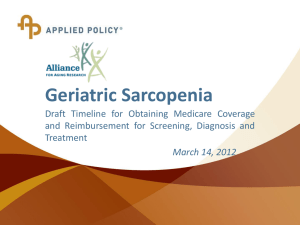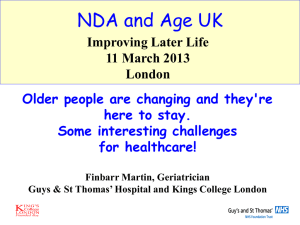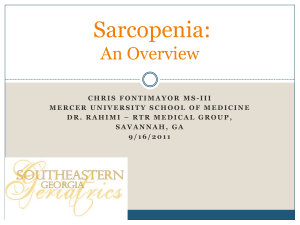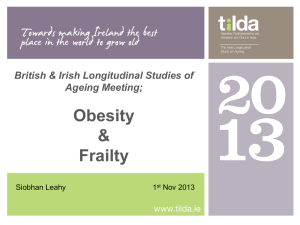sarcopenia
advertisement
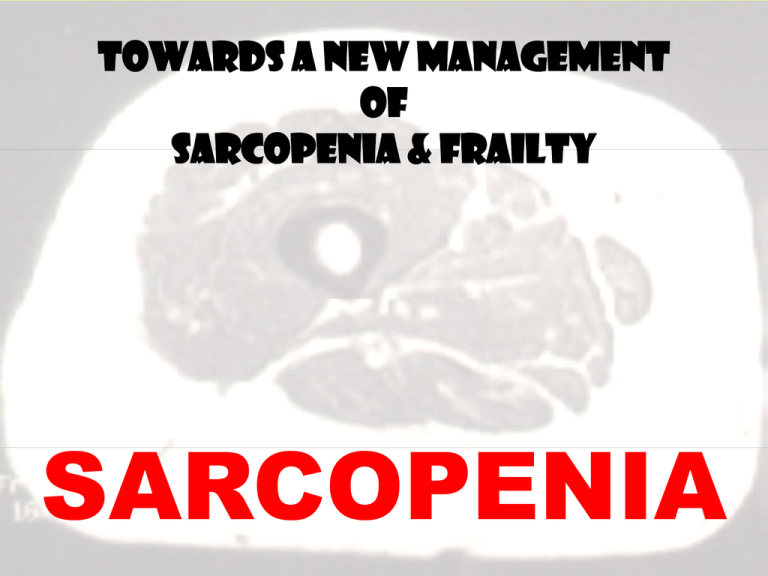
Towards a new management of sarcopenia & frailty SARCOPENIA SARCOPENIA Origins of the term Different proposed definitions Risk factors of sarcopenia Sarcopenia and its closest concepts Consequences of sarcopenia Sarcopenia & frailty: KEY MESSAGES SARCOPENIA: Origins «There is probably no decline in structure and function more dramatic than the decline in lean body mass or muscle mass over the decades of life » Relationship between lean body mass and strength Origins of falls, fractures, loss independence 1988 in Albuquerque « Sarcopenia » In Greek: « Sarx » is Flesh and « Penia » is « Loss » ROSENBERG IH Am J Clin Nutr 1989; 50: 1231-3 & ROSENBERG IH J Nutr 1997; 127: 990S-1S SARCOPENIA: Origins 1988 in Albuquerque « Sarcopenia » In Greek: « Sarx » is Flesh and « Penia » is « Loss » « Age-related loss of muscle mass and function » Is it a process of normative ageing? When does this become a disease state? Can this phenomenon be influenced? 1994 1st Sarcopenia Symposium - NIA ROSENBERG IH Am J Clin Nutr 1989; 50: 1231-3 & ROSENBERG IH J Nutr 1997; 127: 990S-1S SARCOPENIA Origins of the term Different proposed definitions Causes of sarcopenia Sarcopenia and its closest concepts Consequences of sarcopenia Sarcopenia & frailty: KEY MESSAGES SARCOPENIA: definition 1997 Involuntary loss of skeletal muscle mass that occurs with advancing age ROSENBERG IH J Nutr 1997; 127: 990S-1S SARCOPENIA SARCOPENIA: definition 2003 Causes Atrophy and loss of individual muscle cells linked to diminished: - synthesis of muscle proteins - function of mitochondria GREENLUND LJ et al Mech Ageing Dev 2003; 124: 287 SARCOPENIA: definition 2006 Consequences Age-associated loss of skeletal muscle mass, postulated to be a major factor in the strength decline with ageing Moreover, sarcopenia is related to: - functional impairment - disability - falls - loss of independence GOODPASTER BH et al J Gerontol Med Sci 2006; 61A: 1059-64 SARCOPENIA: structures of current definitions CAUSES (and sometimes physiopathology): Age, diet, disuse and « Combination » Loss of skeletal muscle mass Loss of strength CONSEQUENCES: Falls, functional decline, disability, loss of independence and mortality SARCOPENIA Origins of the term Different proposed definitions Risk factors of sarcopenia Sarcopenia and its closest concepts Consequences of sarcopenia Sarcopenia & frailty: KEY MESSAGE Risk factors of Sarcopenia Constitutional factors Ageing process Chronic health conditions Living habits Living conditions CRUZ JENTOFT A et al Curr Opin Clin Nutr Metab Care 2010; 13: 1-7 Risk factors of Sarcopenia Constitutional factors Ageing process Chronic health conditions Female gender Low birth rate Genetic susceptibility Living habits Living conditions CRUZ JENTOFT A et al Curr Opin Clin Nutr Metab Care 2010; 13: 1-7 SARCOPENIA in Caenorhabditis elegans Behavioural phenotypes of ageing 12 days after a synchronized egg lay 40 wild types animals A: Vigorous movement B: Uncoordinated locomotion C: Head and/or tail movements if stimulated HERNDON LA et al Nature 2002; 419: 808-14 SARCOPENIA in Caenorhabditis elegans Cross section of the pharynx 4days HERNDON LA et al Nature 2002; 419: 808-14 18days SARCOPENIA in Caenorhabditis elegans Genetic heterogeneity Mitrochondrial mutations Cross section ofDNA the pharynx Stochastic damage Rate of damage accumulation 4days HERNDON LA et al Nature 2002; 419: 808-14 18days Risk factors of Sarcopenia Constitutional factors Female gender Low birth rate Genetic susceptibility Living habits Malnutrition Low protein intake Alcohol abuse Smoking Physical inactivity Living conditions Starvation Bed rest /immobility /deconditioning Weightlessness Ageing process Increased muscle turnover Catabolic stimuli . Protein degradation . Subclinical inflammation Anabolic stimuli . Protein synthesis Reduced number of muscle cells Myostatin ( recruitment) Apoptosis Hormonal deregulation Testosterone, DHEA production Estrogen production 1-25 (OH)2 vitamin D Thyroid function Growth hormone, IGF-1 Insulin resistance Changes in nervous system CNS input (loss of α-motor neurons) Neuro-muscular disjunction Mitochondrial dysfunction Peripheral vascular flow CRUZ JENTOFT A et al Curr Opin Clin Nutr Metab Care 2010; 13: 1-7 Sarcopenia speed Involuntary degenerative loss of skeletal muscle mass and function occurs at the rate of 1-2% per year after the age of 30 years and accelerates with advancing age Quoted in TIMMERMAN KL et al Curr Opin Clin Nutr Metab Care 2008;11:45-9. Skeletal Muscle Mass (SMI) & Ageing SMI = Muscle mass/body mass x 100 Man 38 y.o. Man 78 y.o. Risk factors of Sarcopenia Constitutional factors Female gender Low birth rate Genetic susceptibility Living habits Malnutrition Low protein intake Alcohol abuse Smoking Physical inactivity Living conditions Starvation Bed rest /immobility /deconditioning Weightlessness Ageing process Increased muscle turnover Catabolic stimuli . Protein degradation . Subclinical inflammation Anabolic stimuli . Protein synthesis Reduced number of muscle cells Myostatin ( recruitment) Apoptosis Hormonal deregulation Testosterone, DHEA production Estrogen production 1-25 (OH)2 vitamin D Thyroid function Growth hormone, IGF-1 Insulin resistance Changes in nervous system CNS input (loss of α-motor neurons) Neuro-muscular disjunction Mitochondrial dysfunction Peripheral vascular flow Chronic health conditions Cognitive impairment Mood disturbances Diabetes mellitus Heart failure Liver failure Renal failure Respiratory failure Osteoarthritis Chronic pain Obesity Catabolic effects of drugs Cancer ? Chronic inflammatory disease ? CRUZ JENTOFT A et al Curr Opin Clin Nutr Metab Care SARCOPENIA Origins of the term Different proposed definitions Risk factors of sarcopenia Sarcopenia and its closest concepts Consequences of sarcopenia Sarcopenia & frailty: KEY MESSAGES Weight loss in older persons: Causes •Voluntary •Involuntary Food restriction Starvation Cachexia Increased exercise Anorexia Sarcopenia THOMAS DR Clin Nutr 2007; 26: 388-99 Weight loss in older persons: 3 categories STARVATION: Pure protein-energy deficiency (reduction of both fat and fat-free mass) Malnutrition in aged adults THOMAS DR Clin Nutr 2007; 26: 388-99 Malnutrition: definition 1. Undernutrition resulting from insufficient food intake 2. Overnutrition caused by excessive food intake 3. Specific nutrient deficiencies 4. Imbalance because of disproportionate intake Geriatric Medicine: 1. Any insufficient dietary intake among essential nutrients 3. Proteino-caloric malnutrition KELLER HH J Am Geriatr Soc 1993; 41: 1212-8 Quoted by DONINI LM et al J Nutr Health Ageing 2007; 11: 421-32 Weight loss in older persons: 3 categories STARVATION: Pure protein-energy deficiency (reduction of both fat and fat-free mass) CACHEXIA: Severe wasting accompanying disease states such as cancer or immunodeficiency (reduction of both fat and fat-free mass) THOMAS DR Clin Nutr 2007; 26: 388-99 CACHEXIA From the Greek words Kákos (bad) and hexis (appearance or condition) Complex syndrome combining: - Weight loss (> 10%) - Reduced food intake (< 1’500 Kcal /day) - Systemic inflammation (CRP > 10 mg / l) + Anorexia & Weakness Linked to the advanced stages of various (CHRONIC) illnesses • Cancer • Heart failure • Obstructive pulmonary disease . Kidney disease • and (…) Altering quality of life FEARON KC et al Clin Nutr 2006; 83: 1345-50 Advanced stages of various conditions / illnesses Food intake Hypermetabolism Pro-inflammatory cytokines CACHEXIA mass MUSCLE strength Adapted from THOMAS DR Clin Nutr 2007; 26: 388-99 Weight loss in older persons: 3 categories STARVATION: Pure protein-energy deficiency (reduction of both fat and fat-free mass) CACHEXIA: Severe wasting accompanying disease states such as cancer or immunodeficiency (reduction of both fat and fat-free mass) SARCOPENIA: Observed age-related decline in muscle mass (reduction fat-free mass, but increase in fat mass) THOMAS DR Clin Nutr 2007; 26: 388-99 SARCOPENIA: definition 2008 Complex multifactorial process facilitated by a combination of voluntary and involuntary factors including the adoption of - more sedentary lifestyle and - a less than optimal diet PADDON-JONES D et al Am J Clin Nutr 2008; 87: 1562S-6S Different kinds of weight loss Cachexia Anorexia Malab sorption Sarcopenia Hyper metabolism ± ± ± Lean tissue Fat tissue Appetite Anemia Yes ± ± = No No Proteolysis Yes No No Yes Yes CRP = = = = Vitamin A = = Albumin ± ± = = = = Weight loss MORLEY JE et al Nutrition 2008; 24: 815-9 Advanced stages of various conditions / illnesses Food intake Hypermetabolism Pro-inflammatory cytokines CACHEXIA mass MUSCLE strength SARCOPENIA AGEING Disuse : Inadequate diet lack of gravity, bed rest or insufficient exercise Hormonal dysregulations Adapted from THOMAS DR Clin Nutr 2007; 26: 388-99 SARCOPENIA Origins of the term Different proposed definitions Risk factors of sarcopenia Sarcopenia and its closest concepts Consequences of sarcopenia Sarcopenia & frailty: KEY MESSAGES Table II: Sarcopenia is a geriatric syndrome Body protein content Thermo regulation Insulin resistance Immunity Infections Risk factors Constitutional factors Female gender Low birth rate Genetic susceptibility Axial muscular tonus Falls Masticator force Venous flow Osteopenia / fractures Ageing Increased muscle turnover Reduced number of muscle cells Hormonal deregulation Changes in nervous system Mitochondrial dysfunction Peripheral vascular flow Living habits Malnutrition Low protein intake Alcohol/ smoking Physical inactivity Chronic health conditions Cognitive impairment Mood disturbances Diabetes mellitus Heart / liver / lung / renal failure Osteoarthritis Chronic pain Drugs Living conditions Starvation Bed rest /immobility /deconditioning Weightlessness SARCOPENIA Frailty Mobility ? Impaired gait Falls Low endurance Physical performance Poor outcomes Disability Poor quality of life Nursing home admission Mortality Qualiy of Life Physical Frailty Care costs CRUZ JENTOFT A et al Curr Opin Clin Nutr Metab Care 2010; 13: 1-7 SARCOPENIA Origins of the term Different proposed definitions Risk factors of sarcopenia Sarcopenia and its closest concepts Consequences of sarcopenia Sarcopenia & frailty: KEY MESSAGES SARCOPENIA FRAILTY REVERSIBILITY NEED of . A consensual working definition . Quantitative diagnostic tools . Promising treatment options Many thanks for your kind invitation

